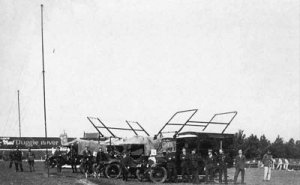After the early success in capturing Dr Crippen in 1910, it was a further ten years before the British police made any further progress in the use of radio to assist their operations.
Between 1920 and 1922, the grand sum of 30 pounds was expended on experiments with "wireless" and the possible future use of "wireless telephony" for police purposes. Receiving apparatus was installed and and engineers commenced experiments in building transmitting equipment at Scotland Yard.
In 1922, Inspector Bannon of "Special Branch" discussed with the Paris police their experience with radio, which had been used to coordinate police response to demonstrations, using radio telephone equipment mounted in an aircraft.
As a result of these inquiries, an agreement was made with the Marconi company to install experimental radio equipment at Scotland Yard, and in a vehicle. The following year, 1923, three Crossley police vans were modified to take the wireless equipment.

1923 - Crossley van with aerial erected
The early mobile equipment in the Crossley vans used a cumbersome aerial system of 5 parallel wires mounted on an adjustable wooden frame on the roof. These were nicknamed "bedsteads". They were replaced in 1926 by less obvious aerials.

Crossley Police vans used by the Metropolitan Police at the Epsom Racecourse in 1924
The Crossleys were used mainly for coordinating special events such as traffic control at race meetings, parades etc. although the "Flying Squad", a special CID patrol unit used two radio equipped vans (actually ex-ambulances).

"Flying Squad" Detectives in their
van with radio operator
These early experiments used radio telephony (voice) transmissions in the medium frequency band (wavelengths used were 265 and 730 meters or in today's terms, frequencies of 1320 and 411 kHz, in and just below the AM broadcast band).
At these frequencies and with the low power being used, interference from trams, and other electrical devices was so heavy that communication was very difficult. It was found that Morse code gave better and more accurate communications than voice transmissions.
The use of Morse code for transmissions had become standard, and by 1926, 12 specially trained radio operators rode in the vans, and manned the base station at Scotland Yard.
Before 1927, radio frequencies were not officially allocated - it was a case of "first come - first served". In 1927 the International Telegraph Convention in Washington designated the frequency allocations for radio services worldwide, and set aside specific frequencies for police use. The wave band allocated was 140- 150 metres (2000 to 2143 kHz). The Post Office, who were responsible for radio licencing allocated four frequencies within this band for police use throughout Britain. The Metropolitan Police used 145 metres (2069 kHz).